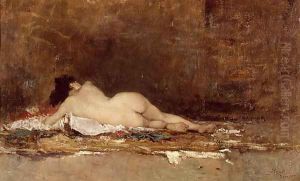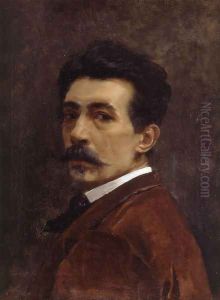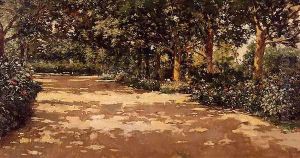Juan Joaquin Agrasot Paintings
Juan Joaquin Agrasot was a prominent Spanish painter born on December 24, 1836, in Orihuela, a small city in the province of Alicante, Spain. Agrasot was an important figure in Spanish art, especially known for his contributions to genre painting and his depictions of everyday life, historical and orientalist themes.
Agrasot received his initial training at the Academy of San Carlos in Valencia where he studied under Francisco Martínez Yago and later, with the Spanish romantic painter Antonio Gisbert. His early works were influenced by the styles of his teachers, but he soon developed his own distinct approach characterized by a delicate and refined use of color and light, a testament to his understanding of the European painting tradition.
In 1860, Agrasot won a scholarship that allowed him to travel to Rome, which was a turning point in his career. There, he came into contact with other Spanish artists and was exposed to the works of the Old Masters. His style evolved as he absorbed the influences of Italian art, particularly the work of the Venetian painters. During his stay in Rome, Agrasot began to gain recognition, and his paintings were well received in major exhibitions.
Upon his return to Spain, Agrasot settled in Valencia, where he became a central figure in the city's artistic community. Throughout his career, he continued to exhibit widely, including at the National Exhibition of Fine Arts (Exposición Nacional de Bellas Artes) in Madrid, where he won several awards. His works often portrayed scenes from Spanish history and literature, as well as traditional Valencian life, capturing the customs and costumes with a romantic sensibility.
Agrasot's contributions extended beyond painting; he was also influential in the development of arts education in Valencia. He was one of the founding members of the Circle of Fine Arts (Círculo de Bellas Artes) in Valencia and played a significant role in the artistic life of the city.
Juan Joaquin Agrasot passed away on January 9, 1919, in Valencia. His legacy lives on through his works, which are held in various museums and collections in Spain and abroad, including the Prado Museum in Madrid and the San Pio V Museum in Valencia. Agrasot is remembered for his masterful technique, his ability to capture the essence of Spanish culture, and his influence on the generations of artists that followed.



